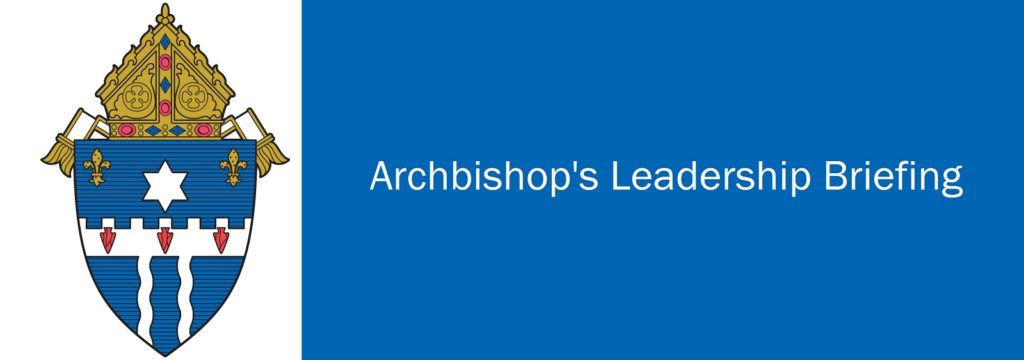 For those of you who may not have seen earlier briefings, I have prepared this Archbishop’s Leadership Briefing to keep archdiocesan leaders informed of important developments in the Church, especially in light of the Church’s response to sexual abuse. Please feel free to forward this information to others. Parishes can use parish communication vehicles (websites, email, social media, Flocknote) to spread the word.
For those of you who may not have seen earlier briefings, I have prepared this Archbishop’s Leadership Briefing to keep archdiocesan leaders informed of important developments in the Church, especially in light of the Church’s response to sexual abuse. Please feel free to forward this information to others. Parishes can use parish communication vehicles (websites, email, social media, Flocknote) to spread the word.
1) I am a member of a task force of the United States Conference of Catholic Bishops, which is composed of the present and past presidents of the Conference. This task force is charged with advancing the proposals for bishops’ accountability identified at the November meeting. As part of our work, we receive regular updates, including recent articles about sexual abuse in the Church. I recommend one to you authored by Msgr. Stephen Rossetti from the magazine The Priest, published by Our Sunday Visitor. Msgr. Rossetti teaches at the Catholic University of America and is a consultor to The Pontifical Commission for the Protection of Minors. This article provides a great overview of how the Church has handled sexual abuse since 2002. You can read it here.
2) We received another good question from one of our pastors who was reflecting concerns he has heard from parishioners. Here is another entry to our frequently asked questions:
Question: As a parent, I am the best protector of my children. Why do I have to attend safe environment training sessions when all of this is happening because of abuse by Catholic clergy?
Answer: There are several reasons why the safe environment training has been so valuable for our Catholic community.
- This training emerged from the reforms of 2002 contained in the Charter for the Protection of Children and Young People, which sought to address the terrible reports of priests and other Church leaders who abused children. No child should ever be abused, especially by someone whose task it is to nurture that child’s faith. In addition to many other reforms, the Charter very wisely called all U.S. dioceses to provide education and training on the issue of childhood sexual abuse for persons of all ages.
- Sexual abuse happens in all segments of society, and 80% of all abused children were abused by parents or other family members.
- The Church is a very large youth-serving organization. We know that one out of four girls and one out of six boys will be abused by the time they reach adulthood. Even if a priest never abused any children, we should be doing this training anyway.
- Because we do live training in the Archdiocese, we are able to interact with thousands of individuals (more than 48,000 since the training started in 2003). After the training, we have people lining up to tell their stories. Just this month, we were told of the arrest of a father who had been abusing his children because one of his adult children attended a safe environment training and felt empowered to report. Others talk to us about their abuse as children. They tell us how the class helped them to recognize that they need help, and we are able to refer them to the assistance they need. Many attendees who come in with skeptical expressions and crossed arms leave with heartfelt thanks for all they learned.
- This training also helps adults who may not have experienced abuse in their own lives recognize the signs of abuse in children they may encounter, whether that abuse happens in the context of the Church, a sports program, or a neighborhood. Many adults are not fully aware of their responsibility to report. In this training, they learn of the mandated reporting laws for all adults in Kentucky to report child abuse, and they learn how to do it.
- The education and empowerment that results from this kind of training, as well as the education provided to children and youth, is one way that we can help to bring about systemic change to combat sexual abuse in our community.
For more frequently asked questions, go here.


